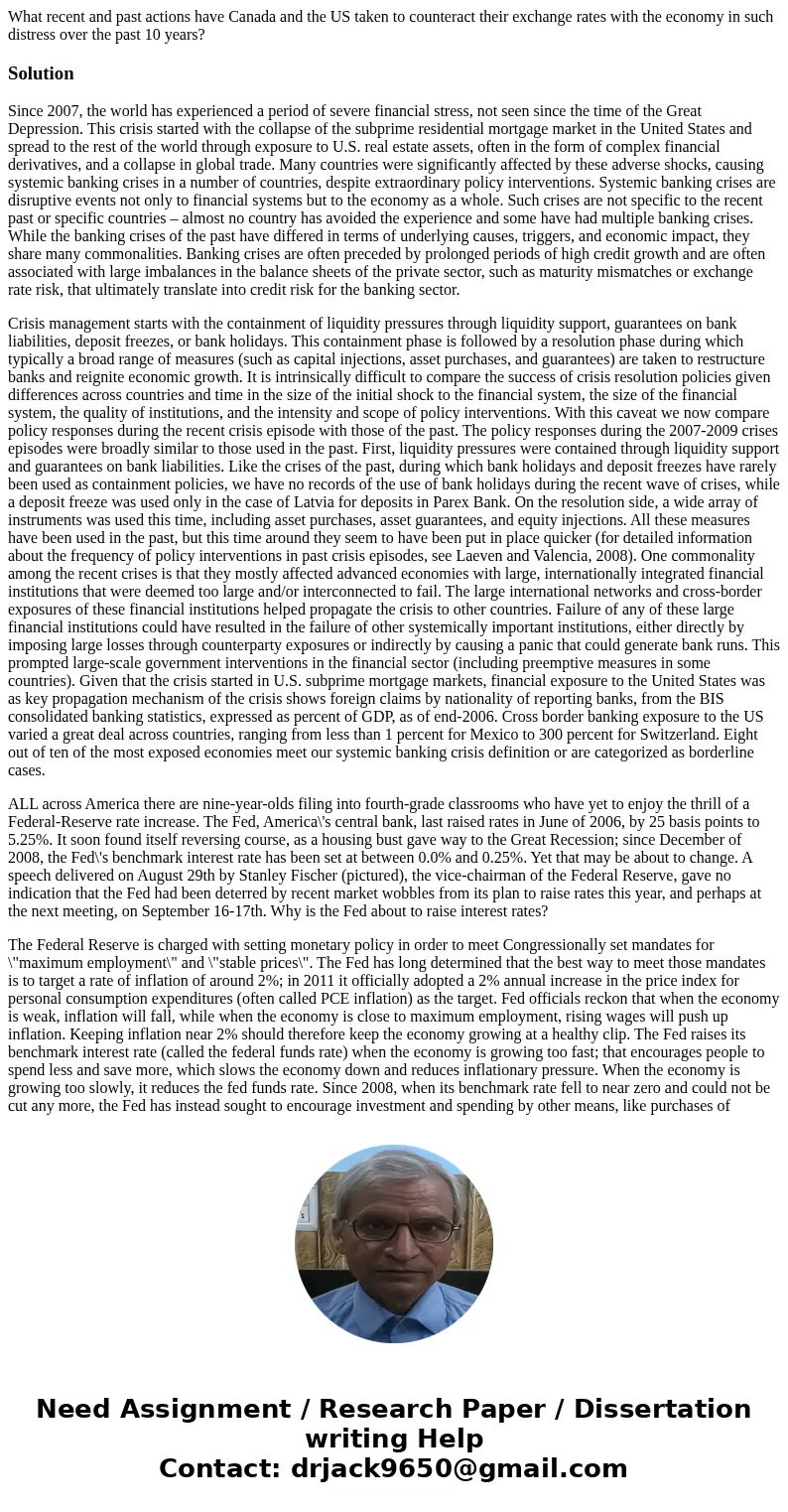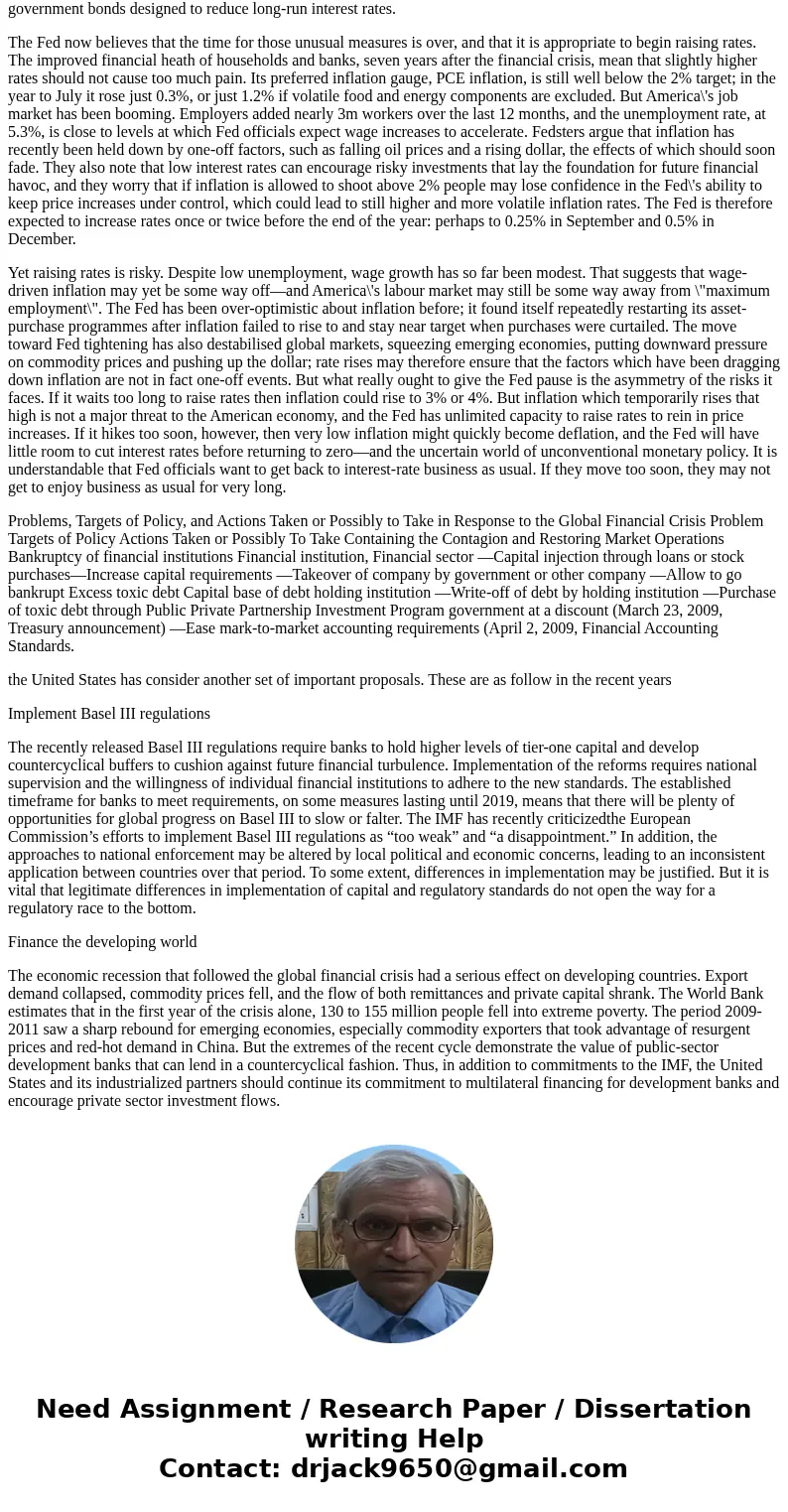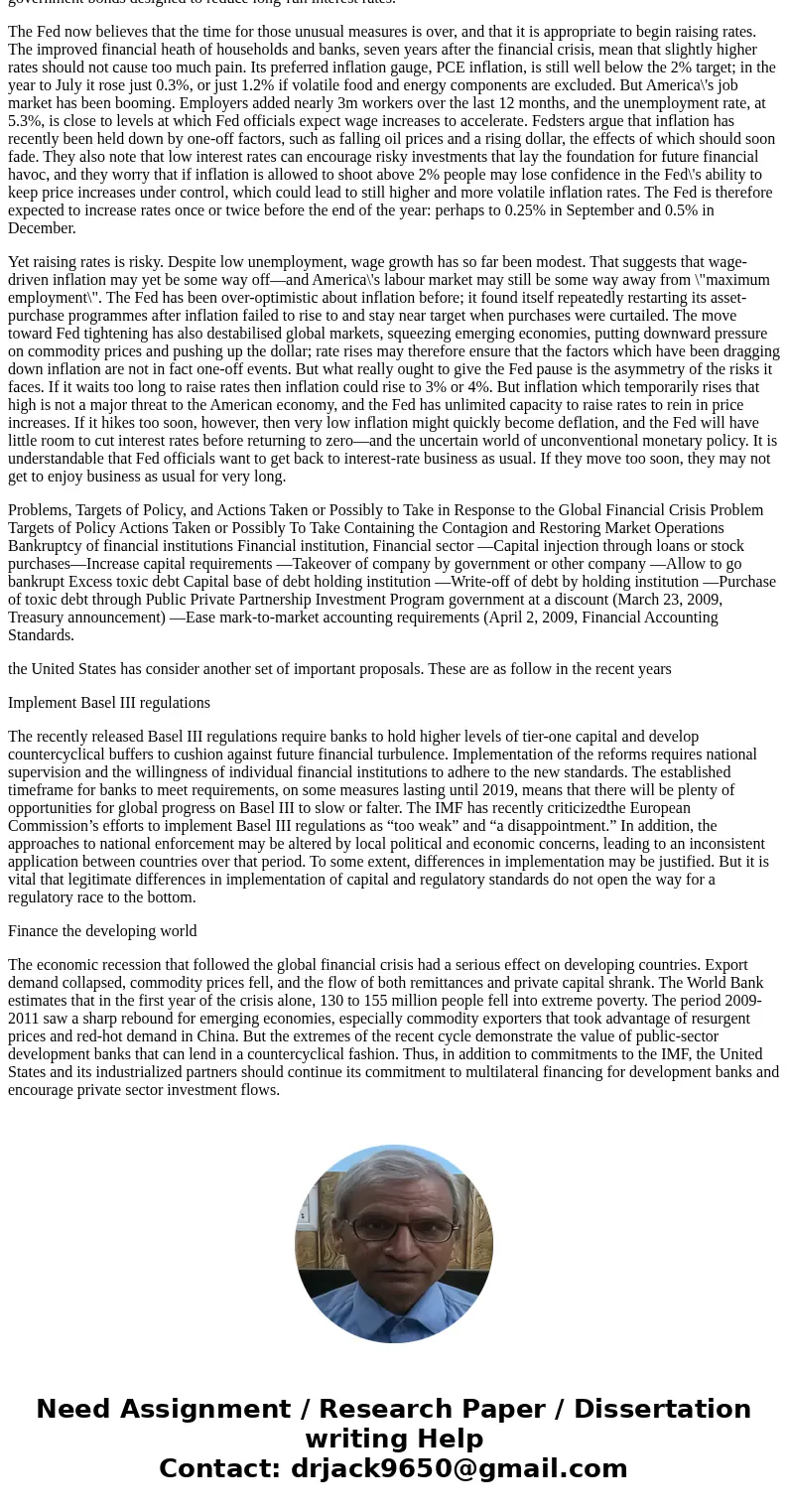What recent and past actions have Canada and the US taken to
What recent and past actions have Canada and the US taken to counteract their exchange rates with the economy in such distress over the past 10 years?
Solution
Since 2007, the world has experienced a period of severe financial stress, not seen since the time of the Great Depression. This crisis started with the collapse of the subprime residential mortgage market in the United States and spread to the rest of the world through exposure to U.S. real estate assets, often in the form of complex financial derivatives, and a collapse in global trade. Many countries were significantly affected by these adverse shocks, causing systemic banking crises in a number of countries, despite extraordinary policy interventions. Systemic banking crises are disruptive events not only to financial systems but to the economy as a whole. Such crises are not specific to the recent past or specific countries – almost no country has avoided the experience and some have had multiple banking crises. While the banking crises of the past have differed in terms of underlying causes, triggers, and economic impact, they share many commonalities. Banking crises are often preceded by prolonged periods of high credit growth and are often associated with large imbalances in the balance sheets of the private sector, such as maturity mismatches or exchange rate risk, that ultimately translate into credit risk for the banking sector.
Crisis management starts with the containment of liquidity pressures through liquidity support, guarantees on bank liabilities, deposit freezes, or bank holidays. This containment phase is followed by a resolution phase during which typically a broad range of measures (such as capital injections, asset purchases, and guarantees) are taken to restructure banks and reignite economic growth. It is intrinsically difficult to compare the success of crisis resolution policies given differences across countries and time in the size of the initial shock to the financial system, the size of the financial system, the quality of institutions, and the intensity and scope of policy interventions. With this caveat we now compare policy responses during the recent crisis episode with those of the past. The policy responses during the 2007-2009 crises episodes were broadly similar to those used in the past. First, liquidity pressures were contained through liquidity support and guarantees on bank liabilities. Like the crises of the past, during which bank holidays and deposit freezes have rarely been used as containment policies, we have no records of the use of bank holidays during the recent wave of crises, while a deposit freeze was used only in the case of Latvia for deposits in Parex Bank. On the resolution side, a wide array of instruments was used this time, including asset purchases, asset guarantees, and equity injections. All these measures have been used in the past, but this time around they seem to have been put in place quicker (for detailed information about the frequency of policy interventions in past crisis episodes, see Laeven and Valencia, 2008). One commonality among the recent crises is that they mostly affected advanced economies with large, internationally integrated financial institutions that were deemed too large and/or interconnected to fail. The large international networks and cross-border exposures of these financial institutions helped propagate the crisis to other countries. Failure of any of these large financial institutions could have resulted in the failure of other systemically important institutions, either directly by imposing large losses through counterparty exposures or indirectly by causing a panic that could generate bank runs. This prompted large-scale government interventions in the financial sector (including preemptive measures in some countries). Given that the crisis started in U.S. subprime mortgage markets, financial exposure to the United States was as key propagation mechanism of the crisis shows foreign claims by nationality of reporting banks, from the BIS consolidated banking statistics, expressed as percent of GDP, as of end-2006. Cross border banking exposure to the US varied a great deal across countries, ranging from less than 1 percent for Mexico to 300 percent for Switzerland. Eight out of ten of the most exposed economies meet our systemic banking crisis definition or are categorized as borderline cases.
ALL across America there are nine-year-olds filing into fourth-grade classrooms who have yet to enjoy the thrill of a Federal-Reserve rate increase. The Fed, America\'s central bank, last raised rates in June of 2006, by 25 basis points to 5.25%. It soon found itself reversing course, as a housing bust gave way to the Great Recession; since December of 2008, the Fed\'s benchmark interest rate has been set at between 0.0% and 0.25%. Yet that may be about to change. A speech delivered on August 29th by Stanley Fischer (pictured), the vice-chairman of the Federal Reserve, gave no indication that the Fed had been deterred by recent market wobbles from its plan to raise rates this year, and perhaps at the next meeting, on September 16-17th. Why is the Fed about to raise interest rates?
The Federal Reserve is charged with setting monetary policy in order to meet Congressionally set mandates for \"maximum employment\" and \"stable prices\". The Fed has long determined that the best way to meet those mandates is to target a rate of inflation of around 2%; in 2011 it officially adopted a 2% annual increase in the price index for personal consumption expenditures (often called PCE inflation) as the target. Fed officials reckon that when the economy is weak, inflation will fall, while when the economy is close to maximum employment, rising wages will push up inflation. Keeping inflation near 2% should therefore keep the economy growing at a healthy clip. The Fed raises its benchmark interest rate (called the federal funds rate) when the economy is growing too fast; that encourages people to spend less and save more, which slows the economy down and reduces inflationary pressure. When the economy is growing too slowly, it reduces the fed funds rate. Since 2008, when its benchmark rate fell to near zero and could not be cut any more, the Fed has instead sought to encourage investment and spending by other means, like purchases of government bonds designed to reduce long-run interest rates.
The Fed now believes that the time for those unusual measures is over, and that it is appropriate to begin raising rates. The improved financial heath of households and banks, seven years after the financial crisis, mean that slightly higher rates should not cause too much pain. Its preferred inflation gauge, PCE inflation, is still well below the 2% target; in the year to July it rose just 0.3%, or just 1.2% if volatile food and energy components are excluded. But America\'s job market has been booming. Employers added nearly 3m workers over the last 12 months, and the unemployment rate, at 5.3%, is close to levels at which Fed officials expect wage increases to accelerate. Fedsters argue that inflation has recently been held down by one-off factors, such as falling oil prices and a rising dollar, the effects of which should soon fade. They also note that low interest rates can encourage risky investments that lay the foundation for future financial havoc, and they worry that if inflation is allowed to shoot above 2% people may lose confidence in the Fed\'s ability to keep price increases under control, which could lead to still higher and more volatile inflation rates. The Fed is therefore expected to increase rates once or twice before the end of the year: perhaps to 0.25% in September and 0.5% in December.
Yet raising rates is risky. Despite low unemployment, wage growth has so far been modest. That suggests that wage-driven inflation may yet be some way off—and America\'s labour market may still be some way away from \"maximum employment\". The Fed has been over-optimistic about inflation before; it found itself repeatedly restarting its asset-purchase programmes after inflation failed to rise to and stay near target when purchases were curtailed. The move toward Fed tightening has also destabilised global markets, squeezing emerging economies, putting downward pressure on commodity prices and pushing up the dollar; rate rises may therefore ensure that the factors which have been dragging down inflation are not in fact one-off events. But what really ought to give the Fed pause is the asymmetry of the risks it faces. If it waits too long to raise rates then inflation could rise to 3% or 4%. But inflation which temporarily rises that high is not a major threat to the American economy, and the Fed has unlimited capacity to raise rates to rein in price increases. If it hikes too soon, however, then very low inflation might quickly become deflation, and the Fed will have little room to cut interest rates before returning to zero—and the uncertain world of unconventional monetary policy. It is understandable that Fed officials want to get back to interest-rate business as usual. If they move too soon, they may not get to enjoy business as usual for very long.
Problems, Targets of Policy, and Actions Taken or Possibly to Take in Response to the Global Financial Crisis Problem Targets of Policy Actions Taken or Possibly To Take Containing the Contagion and Restoring Market Operations Bankruptcy of financial institutions Financial institution, Financial sector —Capital injection through loans or stock purchases—Increase capital requirements —Takeover of company by government or other company —Allow to go bankrupt Excess toxic debt Capital base of debt holding institution —Write-off of debt by holding institution —Purchase of toxic debt through Public Private Partnership Investment Program government at a discount (March 23, 2009, Treasury announcement) —Ease mark-to-market accounting requirements (April 2, 2009, Financial Accounting Standards.
the United States has consider another set of important proposals. These are as follow in the recent years
Implement Basel III regulations
The recently released Basel III regulations require banks to hold higher levels of tier-one capital and develop countercyclical buffers to cushion against future financial turbulence. Implementation of the reforms requires national supervision and the willingness of individual financial institutions to adhere to the new standards. The established timeframe for banks to meet requirements, on some measures lasting until 2019, means that there will be plenty of opportunities for global progress on Basel III to slow or falter. The IMF has recently criticizedthe European Commission’s efforts to implement Basel III regulations as “too weak” and “a disappointment.” In addition, the approaches to national enforcement may be altered by local political and economic concerns, leading to an inconsistent application between countries over that period. To some extent, differences in implementation may be justified. But it is vital that legitimate differences in implementation of capital and regulatory standards do not open the way for a regulatory race to the bottom.
Finance the developing world
The economic recession that followed the global financial crisis had a serious effect on developing countries. Export demand collapsed, commodity prices fell, and the flow of both remittances and private capital shrank. The World Bank estimates that in the first year of the crisis alone, 130 to 155 million people fell into extreme poverty. The period 2009-2011 saw a sharp rebound for emerging economies, especially commodity exporters that took advantage of resurgent prices and red-hot demand in China. But the extremes of the recent cycle demonstrate the value of public-sector development banks that can lend in a countercyclical fashion. Thus, in addition to commitments to the IMF, the United States and its industrialized partners should continue its commitment to multilateral financing for development banks and encourage private sector investment flows.



 Homework Sourse
Homework Sourse